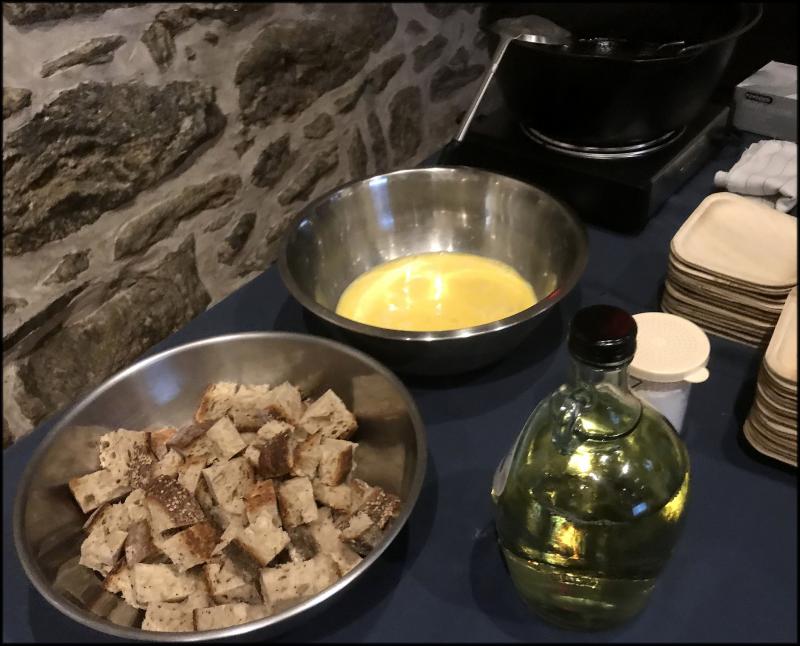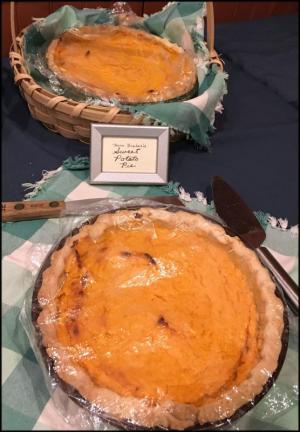Lecture explores history of plantation cooking
Last weekend, Jack and I attended a fascinating lecture at Cliveden in the Germantown neighborhood of Philadelphia. If you visit the site, you’ll find an elegant three-story house built in 1760 by Benjamin Chew as his summer retreat from Center City. Seven subsequent generations of the Chew family lived in the house, until Samuel Chew III donated the entire six-acre property to the National Trust for Historic Preservation in 1972.
The Historic Foodways Society of the Delaware Valley hosted the event, which featured Kelley Fanto Deetz, author of “Bound to the Fire.” The book’s subtitle offered an introduction to the topic of her talk: How Virginia’s Enslaved Cooks Helped Invent American Cuisine. Deetz would cover the highlights of her research into plantation life in Virginia from the 17th century through today.
But, before her talk began, we were treated to coffee and samples of a dish likely made on a plantation – Bread Fritters. Watching the HFSDV volunteer prepare the fritters was an opportunity to see an example of the toils an enslaved cook would face in a hot plantation kitchen where feeding the household was an endless job.
The recipe for these fritters came from “The Virginia Housewife,” published in 1824 and written by Mary Randolph, who was born at Tuckahoe plantation and moved to a large tobacco plantation after her marriage. She was well-known for her expansive, gracious hospitality and exemplified how the mistress of a large Virginia plantation gained prestige through the work performed by her enslaved cooks and maids.
Deetz opened her talk with a passage from her book in which an enslaved cook describes the technique required to make sauces, a complex, multi-step process with remarks on how things can go wrong. And this was just one element of just one of the three extensive meals to be served each day, not to mention impromptu snacks or late suppers as visitors arrived.
One of the interesting anecdotes Deetz shared was the story of George Washington’s personal cook, Hercules, whom she likened to one of the first “celebrity chefs” for his demeanor and skill in the kitchen. When working for then-President Washington in Philadelphia, Hercules would sell the leftover food (slops), earning up to $200 a year.
By all accounts, he used the money to fund his elegant wardrobe, which he donned each evening when work was finished to stroll through Market Street carrying his gold-headed cane. No one is quite sure why Hercules ran away, but many speculate it was because his interaction with the free black citizens of cosmopolitan Philadelphia contrasted harshly with his role as an enslaved cook and laborer at Mount Vernon.
To make her point about how these enslaved cooks enriched American cuisine, Deetz listed a few dishes we now associate with the Southern tradition, but which were actually imported from western Africa and perfected in the plantation kitchen. Thick vegetable stews with okra and sassafras powder are now called filé gumbo. Jollof rice is the savory ancestor of jambalaya, and red red (made with black-eyed peas) is the inspiration for Hoppin’ John.
After the talk, we sampled a variety of goodies made from recipes sourced from the plantation era. The sweet potato pie in the photo was from “What Mrs. Fisher Knows About Old Southern Cooking.” Published in 1881, the cookbook was by former slave Abby Fisher, who couldn’t read or write, but dictated her recipes to friends. Below is her recipe for sweet potato filling, as originally written. This pie was was delicate and delicious with lovely hints of orange.
I’ve also included the recipe for Mary Randolph’s bread fritters, in which she instructs you to “cut the bread to a convenient size.” Each piece of bread becomes a separate fritter, so the pieces should be about the size of a donut hole. The volunteer making these used a whole-grain bread, which added a nice texture.
Although I made a few notes about each recipe, I didn’t change any of the text (the contents of both these books are available online and you can find facsimile reprints). As you can see, cooks in the past wrote recipes for people who already knew their way around the kitchen and just needed a little guidance on how to make a specific dish.
Sweet Potato Pie*
Two pounds of potatoes will make two pies. Boil the potatoes soft; peel and mash fine through a cullender while hot; one tablespoon of butter to be mashed in with the potato. Take five eggs and beat the yolks and whites separate and add one gill of milk; sweeten to taste; squeeze the juice of one orange, and grate one-half the peel into the liquid. One half teaspoonful of salt in the potatoes. Have only one crust and that at the bottom of the plate. Bake quickly.
*As printed in “What Mrs. Fisher Knows About Old Southern Cooking.” One gill is approximately 4 oz or 1/2 C; to sweeten, add 1/2 C to 3/4 C sugar; to cook, preheat oven to 375 F and bake for 35 to 45 minutes.
Bread Fritters*
Cut your bread of a convenient size, pour on it some white wine, and let it stand a few minutes – drain it on a sieve, beat four eggs very light, and add four spoonful of wine, beat all well together – have your lard boiling, dip the bread in the egg, and fry it a light brown; sprinkle sugar on each, and glaze them.
*As printed in “The Virginia Housewife.” For the wine, consider a slightly sweet white, such as Chenin Blanc; after frying, set the pieces on paper towels to drain off excess fat; for the glaze, use powdered confectioners sugar.






















































